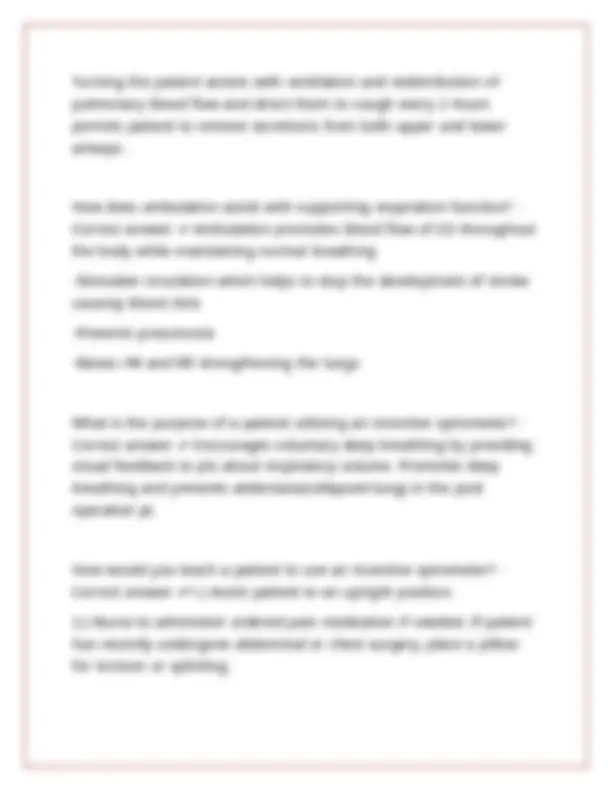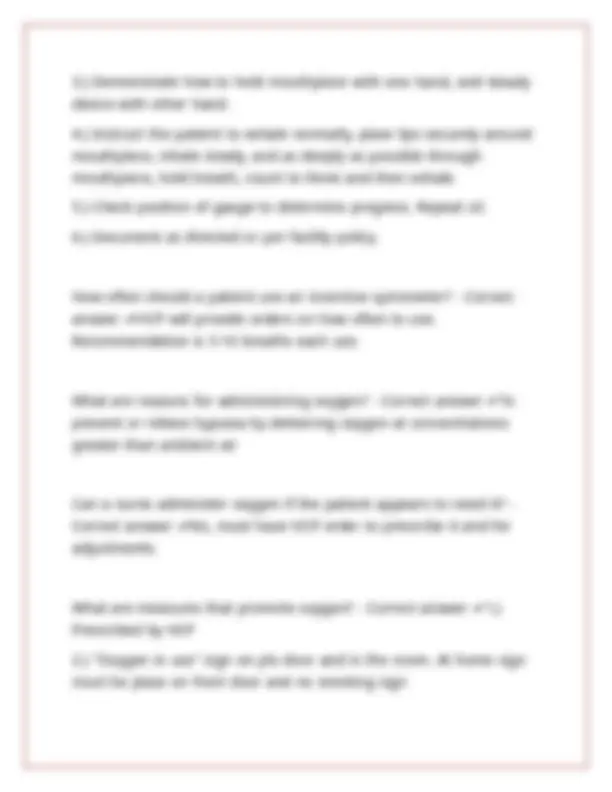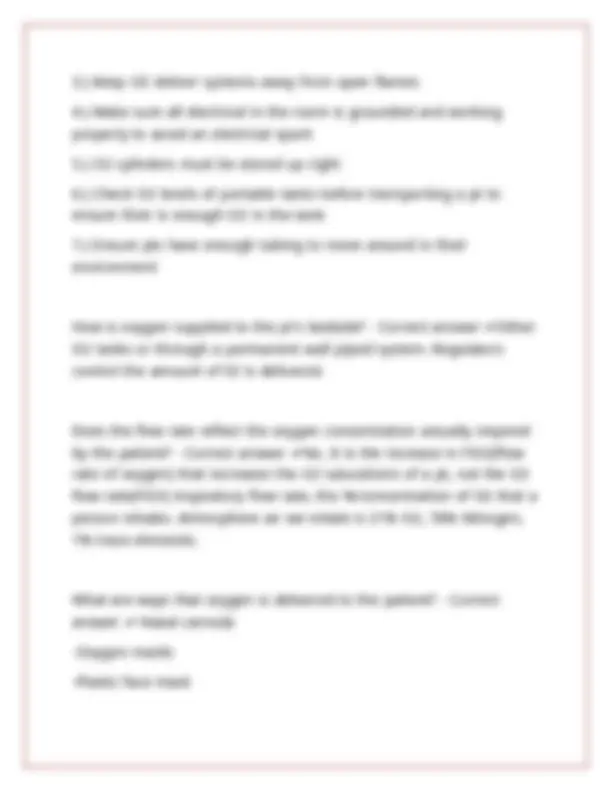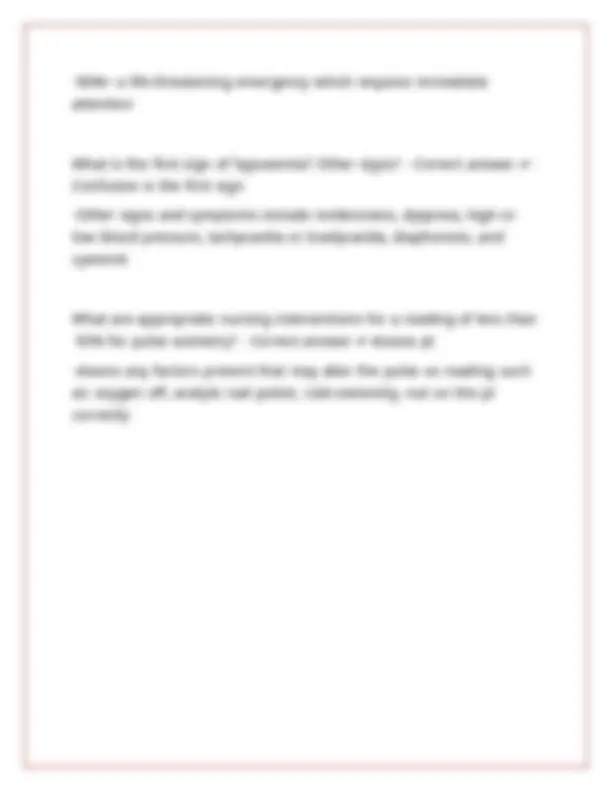






Study with the several resources on Docsity

Earn points by helping other students or get them with a premium plan


Prepare for your exams
Study with the several resources on Docsity

Earn points to download
Earn points by helping other students or get them with a premium plan
Community
Ask the community for help and clear up your study doubts
Discover the best universities in your country according to Docsity users
Free resources
Download our free guides on studying techniques, anxiety management strategies, and thesis advice from Docsity tutors
RNSG 1105 Intro to Nursing Skills I Module 8 Exam with verified solutions
Typology: Exams
1 / 8

This page cannot be seen from the preview
Don't miss anything!





How [] does [] coughing [] assist [] with [] respiratory [] function? [] - [] Correct [] answer [] ✔Permits [] pt [] to [] remove [] secretions [] from [] both [] upper [] and [] lower [] airways How [] does [] breathing [] exercises [] support [] respiratory [] function? [] - [] Correct [] answer [] ✔Improves [] pulmonary [] ventilation What [] is [] the [] difference [] in [] pursed-lip [] breathing [] and [] deep [] breathing? [] - [] Correct [] answer [] ✔-Pursed-lip [] breathing [] involved [] deep [] inspiration [] and [] prolonged [] expiration [] through [] pursed [] lips [] to [] prevent [] alveolar [] collapse. -Diaphragmatic [] breathing [] is [] useful [] for [] pts [] w/pulmonary [] disease [] and [] dyspnea [] secondary [] to [] heart [] failure [] and [] usually [] more [] difficult [] that [] other [] breathing [] methods. How [] would [] you [] teach [] a [] patient [] to [] perform [] pursed-lip [] breathing? [] - [] Correct [] answer [] ✔1.) [] Assess [] pain [] level [] prior [] to [] beginning [] exercises [] and [] medicate [] if [] necessary.
2.) [] Instruct [] the [] patient [] to [] practice [] "Purse [] lips" [] by [] positioning [] lips [] as [] if [] sucking [] through [] a [] straw [] or [] whistling 3.) [] While [] sitting [] up [] the [] patient [] inhales [] through [] the [] nose [] while [] counting [] to [] three [] and [] then [] exhales [] slowly [] and [] evenly [] against [] pursed [] lips [] while [] tightening [] the [] abdominal [] muscles. 4.) [] During [] exhalation, [] have [] the [] patient [] count [] to [] seven. 5.) [] Document [] as [] directed [] or [] per [] facility [] policy. How [] would [] you [] teach [] a [] patient [] to [] perform [] deep [] breathing? [] - [] Correct [] answer [] ✔1.) [] Assess [] pain [] level [] prior [] to [] beginning [] exercises [] and [] medicate [] if [] necessary. 2.) [] Place [] patient [] in [] a [] semi-Fowler's [] position, [] leaning [] forward [] to [] ventilate [] the [] lobes [] of [] the [] lungs. 3.) [] Instruct [] the [] patient [] to: a. [] Inhale [] and [] exhale [] deeply [] and [] slowly [] through [] the [] nose [] two [] times. [] (In [] 2-3-4; [] out [] 2-3-4) b. [] Then [] on [] the [] third [] exhale, [] have [] the [] patient [] cough [] fully [] for [] two [] or [] three [] consecutive [] coughs [] without [] inhaling [] between [] coughs. 4.) [] Repeat [] the [] exercise [] 2 [] or [] 3 [] times [] every [] 2 [] hours [] while [] awake. 5.) [] Document [] as [] directed [] or [] per [] facility [] policy. A [] HCP [] ordered: [] T,C, [] DB [] q [] 2 [] h. [] What [] does [] this [] mean? [] How [] often [] is [] this [] usually [] performed? [] - [] Correct [] answer [] ✔Turn, [] Cough, [] Deep [] breathing [] every [] 2 [] hours.
3.) [] Demonstrate [] how [] to [] hold [] mouthpiece [] with [] one [] hand, [] and [] steady [] device [] with [] other [] hand. 4.) [] Instruct [] the [] patient [] to [] exhale [] normally, [] place [] lips [] securely [] around [] mouthpiece, [] inhale [] slowly, [] and [] as [] deeply [] as [] possible [] through [] mouthpiece, [] hold [] breath, [] count [] to [] three [] and [] then [] exhale. 5.) [] Check [] position [] of [] gauge [] to [] determine [] progress. [] Repeat [] x3. 6.) [] Document [] as [] directed [] or [] per [] facility [] policy. How [] often [] should [] a [] patient [] use [] an [] incentive [] spirometer? [] - [] Correct [] answer [] ✔HCP [] will [] provide [] orders [] on [] how [] often [] to [] use. [] Recommendation [] is [] 5-10 [] breaths [] each [] use. What [] are [] reasons [] for [] administering [] oxygen? [] - [] Correct [] answer [] ✔To [] prevent [] or [] relieve [] hypoxia [] by [] delivering [] oxygen [] at [] concentrations [] greater [] than [] ambient [] air Can [] a [] nurse [] administer [] oxygen [] if [] the [] patient [] appears [] to [] need [] it? [] - [] Correct [] answer [] ✔No, [] must [] have [] HCP [] order [] to [] prescribe [] it [] and [] for [] adjustments. What [] are [] measures [] that [] promote [] oxygen? [] - [] Correct [] answer [] ✔1.) [] Prescribed [] by [] HCP 2.) [] "Oxygen [] in [] use" [] sign [] on [] pts [] door [] and [] in [] the [] room. [] At [] home [] sign [] must [] be [] place [] on [] front [] door [] and [] no [] smoking [] sign
3.) [] Keep [] O2 [] deliver [] systems [] away [] from [] open [] flames 4.) [] Make [] sure [] all [] electrical [] in [] the [] room [] is [] grounded [] and [] working [] properly [] to [] avoid [] an [] electrical [] spark 5.) [] O2 [] cylinders [] must [] be [] stored [] up [] right 6.) [] Check [] O2 [] levels [] of [] portable [] tanks [] before [] transporting [] a [] pt [] to [] ensure [] their [] is [] enough [] O2 [] in [] the [] tank 7.) [] Ensure [] pts [] have [] enough [] tubing [] to [] move [] around [] in [] their [] environment How [] is [] oxygen [] supplied [] to [] the [] pt's [] bedside? [] - [] Correct [] answer [] ✔Either [] O2 [] tanks [] or [] through [] a [] permanent [] wall [] piped [] system. [] Regulators [] control [] the [] amount [] of [] 02 [] is [] delivered. Does [] the [] flow [] rate [] reflect [] the [] oxygen [] concentration [] actually [] inspired [] by [] the [] patient? [] - [] Correct [] answer [] ✔No. [] It [] is [] the [] increase [] in [] FiO2(flow [] rate [] of [] oxygen) [] that [] increases [] the [] O2 [] saturations [] of [] a [] pt, [] not [] the [] O2 [] flow [] rate(FiO2) [] inspiratory [] flow [] rate, [] the [] %/concentration [] of [] O2 [] that [] a [] person [] inhales. [] Atmosphere [] air [] we [] inhale [] is [] 21% [] O2, [] 78% [] Nitrogen, [] 1% [] trace [] elements. What [] are [] ways [] that [] oxygen [] is [] delivered [] to [] the [] patient? [] - [] Correct [] answer [] ✔-Nasal [] cannula -Oxygen [] masks -Plastic [] face [] mask
-Face [] mask [] goes [] over [] the [] nose [] and [] mouth [] with [] a [] strap [] behind [] the [] head. [] Adjust [] the [] elastic [] strap [] to [] fit [] snugly [] but [] comfortably [] on [] the [] face. [] Remove [] the [] mask [] and [] dry [] skin [] every [] 2 [] to [] 3 [] hours [] if [] the [] oxygen [] is [] running [] continuously. [] Do [] not [] use [] powder [] around [] the [] mask. What [] does [] a [] pulse [] oximeter [] measure? [] - [] Correct [] answer [] ✔It [] detects [] the [] amount [] of [] oxygen [] bound [] to [] hemoglobin [] molecules [] and [] calculates [] the [] pulse [] saturation Which [] sites [] on [] the [] body [] are [] appropriate [] to [] measure [] oxygen [] saturation [] via [] pulse [] oximeter? [] - [] Correct [] answer [] ✔Can [] be [] placed [] on [] fingers, [] earlobes, [] forehead, [] bridge [] of [] an [] adult's [] nose [] or [] on [] the [] sole [] of [] an [] infants [] foot What [] patient [] conditions [] would [] the [] pulse [] oximeter [] measurement [] be [] helpful? [] - [] Correct [] answer [] ✔-Tachycardia -Bradycardia -Dysrhythmias What [] is [] a [] normal [] oximetry [] reading? [] - [] Correct [] answer [] ✔-Normal [] saturation= [] 95%-100% What [] pulse [] oximetry [] reading [] level [] would [] cause [] concern [] for [] hypoxemia? [] - [] Correct [] answer [] ✔-95%= [] oxygenation [] problems
-90%= [] a [] life-threatening [] emergency [] which [] requires [] immediate [] attention What [] is [] the [] first [] sign [] of [] hypoxemia? [] Other [] signs? [] - [] Correct [] answer [] ✔- Confusion [] is [] the [] first [] sign -Other [] signs [] and [] symptoms [] include [] restlessness, [] dyspnea, [] high [] or [] low [] blood [] pressure, [] tachycardia [] or [] bradycardia, [] diaphoresis, [] and [] cyanosis What [] are [] appropriate [] nursing [] interventions [] for [] a [] reading [] of [] less [] than [] 95% [] for [] pulse [] oximetry? [] - [] Correct [] answer [] ✔-Assess [] pt -Assess [] any [] factors [] present [] that [] may [] alter [] the [] pulse [] ox [] reading [] such [] as: [] oxygen [] off, [] acetylic [] nail [] polish, [] cold [] extremity, [] not [] on [] the [] pt [] correctly